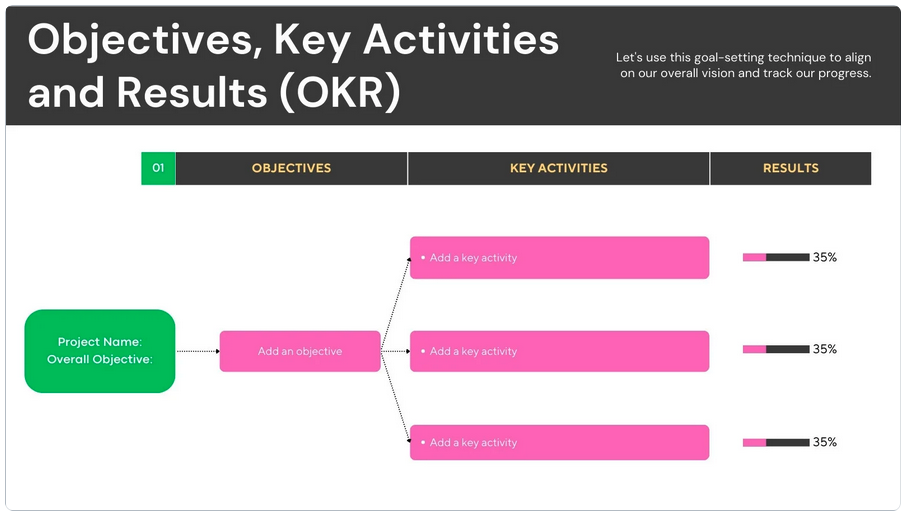
Overview
Objectives and Key Results (OKRs) have become a popular framework for setting and achieving business goals. Used effectively, OKRs can align teams, prioritize efforts, and drive measurable outcomes. But crafting impactful OKRs requires a clear strategy and an understanding of your business’s unique needs. In this article, we’ll explore how to write business OKRs that deliver real results.

What Are OKRs?
OKRs consist of two key components:
- Objectives: Ambitious, qualitative goals that describe what you want to achieve.
- Example: “Increase customer satisfaction to become the go-to brand for our industry.”
- Key Results: Specific, measurable outcomes that indicate success in achieving the objective.
- Example: “Achieve an NPS score of 80 by Q4.”
Together, they provide a framework for setting clear goals and tracking progress.
Why Are OKRs Effective?
- Focus: They prioritize what matters most, eliminating distractions.
- Alignment: OKRs connect individual, team, and organizational goals.
- Accountability: Measurable key results ensure progress is trackable.
- Agility: Regular reviews allow for adjustments as circumstances change.
Steps to Writing Effective OKRs
1. Define Your Objective
Your objective should be ambitious, inspiring, and aligned with your business strategy. It answers what you want to achieve.
Characteristics of a Strong Objective:
- Aligned: Supports the broader organizational goals.
- Aspirational: Pushes boundaries and inspires action.
- Simple: Easy to understand and communicate.
Examples:
- Poor: “Improve our website.”
- Strong: “Redesign our website to deliver a best-in-class user experience.”
2. Identify Measurable Key Results
Key results define how you will achieve the objective. They should be specific, quantifiable, and time-bound.
Characteristics of Key Results:
- Measurable: Can be tracked with numbers or milestones.
- Achievable: Realistic within the given timeframe.
- Outcome-Oriented: Focus on results, not tasks.
Examples:
- Poor: “Work on the website redesign.”
- Strong: “Increase website conversion rate from 3% to 5% by Q4.”
3. Ensure Alignment Across Teams
OKRs work best when everyone in the organization is aligned. Each team’s objectives should contribute to the company’s overall goals.
Steps for Alignment:
- Start with top-level organizational OKRs.
- Cascade objectives to teams and individuals.
- Use collaborative tools (e.g., ClickUp, Asana, or Lattice) to track progress and ensure transparency.
Example of Alignment:
- Company Objective: “Expand our market presence in Southeast Asia.”
- Marketing Team Objective: “Increase brand awareness in Southeast Asia.”
- Key Results for Marketing:
- Launch three targeted ad campaigns by Q2.
- Increase social media followers in the region by 20%.
4. Make Them Ambitious Yet Realistic
Ambitious goals inspire teams, but they must also be achievable to maintain motivation.
Tips for Balancing Ambition and Realism:
- Use historical data to set benchmarks.
- Ensure resources and support are available.
- Regularly review progress to recalibrate if necessary.
5. Limit the Number of OKRs
Too many OKRs can dilute focus and overwhelm teams. Stick to 3-5 objectives per team or individual.
Why It’s Important:
- Keeps priorities clear and actionable.
- Ensures teams are not spread too thin.
6. Focus on Outcomes, Not Activities
OKRs should measure the impact of your actions, not just the actions themselves.
Examples:
- Activity-Based KR: “Publish 10 blog posts.”
- Outcome-Based KR: “Increase website traffic by 30% through content marketing.”
7. Set a Timeframe
Establish a clear period for achieving each OKR, typically quarterly or annually.
Why It Matters:
- Creates a sense of urgency.
- Provides a natural review point to assess progress.
Common OKR Mistakes to Avoid
- Vague Objectives
- Weak: “Grow our business.”
- Strong: “Increase revenue by 20% through new customer acquisition by Q4.”
- Unmeasurable Key Results
- Weak: “Improve team performance.”
- Strong: “Increase team productivity score from 7.5 to 9.0 in employee surveys by year-end.”
- Setting Too Many OKRs
- Focus on what truly matters to avoid spreading your team too thin.
- Ignoring Progress Reviews
- Regularly check progress and adjust strategies as needed.
Reviewing and Refining OKRs
- Weekly Check-Ins: Monitor progress on key results.
- Monthly Reviews: Adjust tactics to stay on track.
- Quarterly Assessments: Evaluate overall performance and set new OKRs.
Tools for Managing OKRs
- ClickUp: For setting, tracking, and aligning OKRs across teams.
- Lattice: Ideal for integrating OKRs into performance reviews.
- Google Sheets: A simple and cost-effective way to manage OKRs.
- Asana: Useful for linking OKRs to daily tasks and projects.
Examples of Well-Written OKRs
Objective: Increase customer satisfaction and loyalty.
- Key Result 1: Improve Net Promoter Score (NPS) from 70 to 85 by Q3.
- Key Result 2: Reduce customer churn rate from 5% to 3% by year-end.
- Key Result 3: Achieve a customer support satisfaction score of 95%.
Objective: Drive e-commerce revenue growth.
- Key Result 1: Increase monthly website traffic from 50,000 to 75,000 visitors by Q2.
- Key Result 2: Improve conversion rate from 2.5% to 4% by Q3.
- Key Result 3: Generate $500,000 in online sales by year-end.
Conclusion
Writing effective OKRs is both an art and a science. By focusing on clarity, alignment, and measurability, you can create OKRs that inspire action and deliver tangible results. Remember to keep them ambitious but realistic, prioritize outcomes over activities, and review progress regularly. With a disciplined approach, OKRs can become a powerful tool for driving your business’s success.















